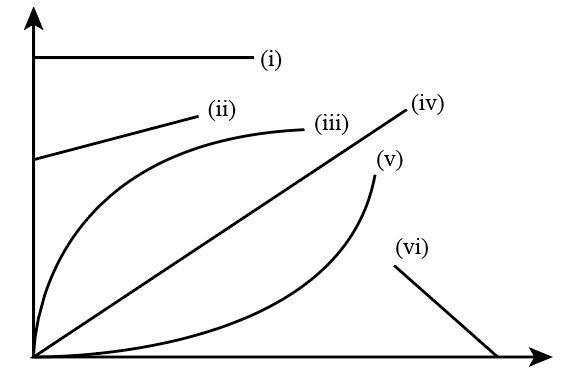
In figure shows the velocity-time graph for various situations. What does each graph indicate?


Answer
486.9k+ views
Hint: We are given with the velocity-time graph of a body for various conditions. Velocity is represented on the y-axis, and time is represented on the x-axis. We will closely observe each slope one by one to find the relationship between velocity and time.
Complete step by step answer:
From the slope of equation (i), we see that the velocity is not changing with the time, that means it is constant. From the slope of equation (i) we can write:
Here V is the velocity of the given body and c is a constant.
From equation (ii), we see that at the start of the slope, there is some velocity attained by the object and after that velocity is increasing linearly with time. Therefore, the object has some initial velocity which is independent of time so we can write:
Here a and b are constant values, and t is time.
From the slope of equation (iii), we can conclude that the velocity of the given object is a square root function of time so we can write the equation for this situation as below:
On observing the slope of equation (iv), we find that the velocity is increasing linearly with the time, that means it has a linear relationship with time which can be expressed as:
From the slope of equation (v), we can write that the velocity is a square function of time, or we can say it is increasing with time in a quadratic form.
On closely observing the slope of equation (vi), we can see that velocity has some initial fixed value then it is decreasing with time by following a linear relationship so we can write:
Note:
We can remember that if the slope of a body on the velocity-time graph is following a downward concave path, that means velocity is a square root function of time and if the slope is concave upward, velocity is in quadratic relationship with time.
Complete step by step answer:
From the slope of equation (i), we see that the velocity is not changing with the time, that means it is constant. From the slope of equation (i) we can write:
Here V is the velocity of the given body and c is a constant.
From equation (ii), we see that at the start of the slope, there is some velocity attained by the object and after that velocity is increasing linearly with time. Therefore, the object has some initial velocity which is independent of time so we can write:
Here a and b are constant values, and t is time.
From the slope of equation (iii), we can conclude that the velocity of the given object is a square root function of time so we can write the equation for this situation as below:
On observing the slope of equation (iv), we find that the velocity is increasing linearly with the time, that means it has a linear relationship with time which can be expressed as:
From the slope of equation (v), we can write that the velocity is a square function of time, or we can say it is increasing with time in a quadratic form.
On closely observing the slope of equation (vi), we can see that velocity has some initial fixed value then it is decreasing with time by following a linear relationship so we can write:
Note:
We can remember that if the slope of a body on the velocity-time graph is following a downward concave path, that means velocity is a square root function of time and if the slope is concave upward, velocity is in quadratic relationship with time.
Latest Vedantu courses for you
Grade 9 | CBSE | SCHOOL | English
Vedantu 9 CBSE Pro Course - (2025-26)
School Full course for CBSE students
₹37,300 per year
Recently Updated Pages
Master Class 9 General Knowledge: Engaging Questions & Answers for Success

Master Class 9 English: Engaging Questions & Answers for Success

Master Class 9 Science: Engaging Questions & Answers for Success

Master Class 9 Social Science: Engaging Questions & Answers for Success

Master Class 9 Maths: Engaging Questions & Answers for Success

Class 9 Question and Answer - Your Ultimate Solutions Guide

Trending doubts
State and prove Bernoullis theorem class 11 physics CBSE

What are Quantum numbers Explain the quantum number class 11 chemistry CBSE

Who built the Grand Trunk Road AChandragupta Maurya class 11 social science CBSE

1 ton equals to A 100 kg B 1000 kg C 10 kg D 10000 class 11 physics CBSE

State the laws of reflection of light

One Metric ton is equal to kg A 10000 B 1000 C 100 class 11 physics CBSE




